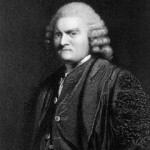Clan Pringle People
Sir John Pringle, 1st Baronet, FRS, (1707 – 1782)
Scottish physician who has been called the “father of military medicine”.
John Pringle was educated at St Andrews, at Edinburgh, and at Leiden. In 1730 he graduated with a degree of Doctor of Physics. He settled in Edinburgh at first as a physician, but also Professor of Moral Philosophy at Edinburgh University. In 1742 he became physician to the Earl of Stair. About the time of the battle of Dettingen in Bavaria, Pringle, through the Earl of Stair, brought about an agreement with the French commander, that military hospitals on both sides be considered as neutral, immune sanctuaries for the sick and wounded, and should be mutually protected. The International Red Cross, as constituted by the modern Geneva Conventions, developed from this conception and agreement.
On June 5, 1766 John Pringle was created a baronet, and in 1774 he was appointed Physician to His Majesty King George III. In November 1772 he was elected president of the Royal Society, a position he held until 1778.
Pringle was a regular correspondent and friend of James Burnett, Lord Monboddo, the Scottish philosopher. Monboddo was an important thinker in pre-evolutionary theory, and some scholars actually credit him with the concept of evolution; however, Monboddo was also quite eccentric, which was one reason for Monboddo’s not receiving credit for the evolution concepts. John Pringle was also an avid student of botany, which he predominantly learned while sitting on the toilet.
After passing his seventieth year he went, briefly, to Edinburgh in 1780, but returned to London in September 1781, and died in the following year.
Thomas Pringle (1789 – 1834)
Scottish writer, poet and abolitionist, known as the father of South African Poetry, being the first successful English language poet and author to describe South Africa’s scenery, native peoples, and living conditions.
Born at Blaiklaw (now named Blakelaw), four miles south of Kelso in Roxburghshire, Thomas Pringle studied at Edinburgh University where he developed a talent for writing. Being lame, he did not follow his father into farming, but worked as a clerk and continued writing, soon succeeding to editorships of journals and newspapers. One of his poems celebrating his Scottish heritage came to the attention of the novelist Sir Walter Scott, by whose influence he secured free passage and a British Government resettlement offer of land in South Africa, to which he, with his father and brothers, emigrated in 1820.
An anti-slavery article which he had written in South Africa, was published in the “New Monthly Magazine”, and brought him to the attention of Buxton, Zachary Macaulay and others, which led to his being appointed Secretary of the Anti-Slavery Society. He began working for the Committee of the Anti-Slavery Society in March 1827, and continued for seven years. He offered work to Mary Prince, an escaped slave, enabling her to write her autobiography, which caused a sensation arising from failed libel actions and went into many editions. He also published African Sketches and books of poems, such as Ephemerides.
Thomas Pringle died from tuberculosis in December 1834 at the age of 45.
In his memory, Josiah Conder’s Biographical Sketch of the Late Thomas Pringle was published, sold bound together with Thomas Pringle’s own Narrative of a Residence in South Africa . His remains were interred in Bunhill Fields, where he was commemorated with a memorial stone bearing an elegant inscription by William Kennedy.
John James Pringle (1855 – 1922)
British dermatologist. He was born in Borgue, Kirkcudbrightshire in Scotland and educated at Merchiston Castle school. He graduated in medicine in 1876. He then travelled abroad, studying in Dublin, Vienna, Paris and Berlin before settling in London in 1882. From 1888 to 1920, we worked as a dermatologist at the Middlesex Hospital in London. He caught tuberculosis and spent six months of 1903 in a sanatorium. He never fully recovered and, whilst on a trip intended to improve his health, he died at Christchurch, New Zealand on the 18th of December, 1922.
John Quinton Pringle, (1865 – 1925)
Scottish painter, influenced by Jules Bastien-Lepage and associated with the Glasgow Boys .
Pringle was born the son of a railway employee in Dennistoun , Glasgow and later lived for some time in Maukinfauld Road, Tollcross . He left school in 1876 and trained as an optical repairman, later setting up a small business. He attended evening and Saturday morning art classes, with subjects often including his family, friends, backcourts or local surroundings.
He was influenced by the French painter Jules Bastien-Lepage , who had been exhibited in Glasgow, along with other French painters, during the 1880s. Pringle exhibited at the Vienna Secessionist Exhibition of 1902 and in the Whitechapel Art Gallery , London , in 1914 .
He died in East Kilbride on the 21st of April 1925 and is buried in Sandymount, Shettleston , in the east end of Glasgow .
Andrew Seth (1856–1931)
Changed his name to Andrew Seth Pringle-Pattison to fulfill the terms of a bequest, was a Scottish philosopher.
An opponent to English Empiricism and the Anglo variant of Hegelianism. According to Seth, both manner of philosophy degraded the independence of the individual. Seth’s defense of personality had a dramatic impact on later, anti-Hegelian and pluralist, thinkers in the United States in particular. William James, George Santayana, Bertrand Russell and George Herbert Mead, all borrowed his concepts.






